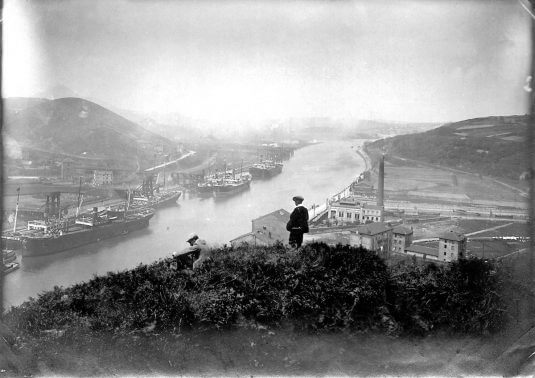The Department of Culture and Linguistic Policy of the Autonomous Basque Government, the Barakaldo Town Council and the Port Authority of Bilbao have reached an agreement to promote, restore, preserve and maintain the existing minerals loading bays in the Port’s service zone that are inside the Barakaldo town limits with a view to encouraging the public, and especially the inhabitants of Barakaldo, to use them for recreation.
The agreement was announced today at the Port Authority headquarters by the Basque Government deputy for Culture and Linguistic Policy, Bingen Zupiria, the Mayor of Barakaldo, Amaia del Campo and the Port Authority Chairman, Ricardo Barkala.
The old minerals loading bays inside the Barakaldo municipal boundaries are located upstream and downstream of Rontegui Bridge. Most of them are facilities of historic-artistic and/or architectural interest inside the Port of Bilbao service zone. This is why an inter-administrations agreement has been reached, whose actions and objectives will be set out in an action protocol to be signed in the coming weeks, once the Government Cabinet has been informed.
The following are among the actions and objectives set out:
- An analysis of the historic-artistic and/or architectural singularity and relevance of the old loading bays on the River Nervion, and particularly those known as Orconera, Sefanitro y Cía and Franco Belga, as well as the technical and economic viability regarding their eventual restoration and preservation.
- The results of the above-mentioned shared analysis, including its technical and economic viability will lead to the promotion, where proceeding, of the recognition by the competent General State Administration of the historic-artistic and/or architectural singularity and relevance of these bays, or of some of them.
- Processing of the aids available for financing the restoration, preservation or improvement of property belonging to Historic Spanish Heritage, which are set out in the “1.5% Cultural” programme run by the Ministry for Culture and Sport, which is partially funded by the Port Authority of Bilbao through its annual investments in the port works it promotes. In fact, Article 68.1 of Law 16/1985, and article 58.1 of Royal Decree 111/1986 of January 10, pertaining to the partial development of the previous law, establish that the destination of income proceeding from the above-mentioned programme, will be to finance preservation or improvement works on Historic Spanish Heritage, or to encourage artistic creativity “preferably in the work itself or in its immediate surroundings”.
- Examination and establishing formulas for the concession/and or exploitation and management of the stipulated properties located in the Port service zone once they have been restored, in accordance with what is set out in the Revised State Port and Merchant Navy Law, and in the Legislation pertaining to Public Heritage Administration with a view to facilitating their preservation or interaction with Barakaldo residents within municipal business.
- Where necessary, to commence proceedings for the modification of port or municipal planning instruments, including an eventual release from public domain of port properties to place them under municipal management.
Artistic Industrial Heritage
During the nineteenth century, due to the great iron mining and exporting activity, there were 23 loading bays from Olabeaga to the present-day La

Benedicta basin. Rail transport, together with the loading needs of the boats themselves and the tides, defined a certain type of loading bay that characterised and made up the limits of the River, with the construction of an important identifiable landscape composition of historic value.
The General Basque Cultural Heritage List, includes the mineral wharves and loading bays of Baracaldo in its monumental complex category (Administrative Resolution 12 September 2016).
These wharves are:
- The Franco-Belga Company had three dating from 1886. Only the one called Nº 3 is preserved, which was restored after a fire in 2002. It is one of the few loading bays built thanks to the initiative of different companies and has survived to the present with many of its original elements. It is the one nearest to the mouth of the River Galindo. These bays were in active service, with different owners, until the 1980s.
- The Orconera Iron Ore Company Limited company was one of the most important mining affiliates set up between 1871 and 1876 by European iron and steel companies in Biscay. Five loading bays were built, all with similar characteristics. At present, those preserved are Loading Bay Nº1 (built in 1876) which still preserves the majority of its structure. Of the rest, Bays Nº 3 and Nº 4 have little more than the gantries over the water at the ends, as well as the remains of the wharves formed by planks supported on wooden stanchions.
The Orconera iron ore loading bay, together with Dunston Staiths of Gateshead coal bay are considered to be the only two eighteenth century wooden-structured bays submerged in water still standing in the world.
- The Sefanitro loading bay, which is a structure raised over the rail tracks, is a later construction associated with the Sociedad Española de Fabricaciones Nitrogenadas, S.A company, founded in 1941. The company developed a great group of buildings designed by the architects Germán Agirre and Hilario Imaz. These buildings incorporate characteristics of rationalist-expressionist architecture. It is an architectural style which solves the problem of the loading bay that connected the industrial complex with the loading point on the River.

 Port access
Port access